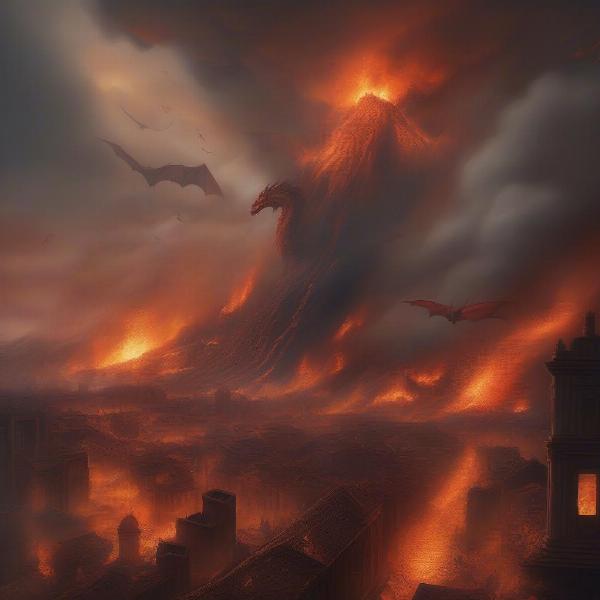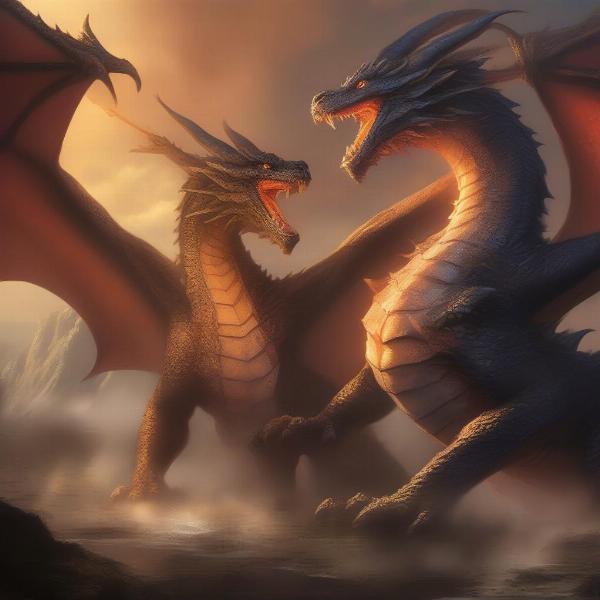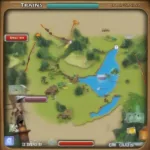The demise of dragons before the events of Game of Thrones is a question that sparks curiosity among fans. While Daenerys Targaryen’s dragons reignited the awe and fear of these magnificent creatures, the history books of Westeros tell tales of a time when dragons were far more common, only to mysteriously vanish. Understanding the decline and eventual extinction of dragons before the Targaryen conquest adds a layer of depth to the lore of the series and provides insight into the fragility of power, even for seemingly invincible beasts.
The Doom of Valyria and the First Dragon Decline
The most significant event contributing to the dwindling dragon population was the Doom of Valyria. This cataclysmic event, shrouded in mystery, shattered the Valyrian Freehold, a powerful empire built on dragonfire and dominance. The Doom, a volcanic eruption of unprecedented scale, not only destroyed the Valyrian peninsula but also wiped out a vast number of dragons. The exact cause of the Doom remains unknown, with theories ranging from volcanic activity to a magical backlash. However, the consequence was clear: the near-total annihilation of the Valyrian dragonlords and their magnificent beasts.
The Few Survivors of the Doom
 The Doom of Valyria and the Death of Dragons
The Doom of Valyria and the Death of Dragons
While the Doom decimated the dragon population, a few survived. House Targaryen, having relocated to Dragonstone years prior, possessed the only known surviving dragons in the world. This stroke of luck, or perhaps foresight, allowed them to conquer Westeros centuries later, using their dragons as instruments of war and symbols of power. However, even the Targaryen dragons began to dwindle.
The Dance of the Dragons: A Civil War of Fire and Fury
The Targaryen civil war known as the “Dance of the Dragons” further diminished the dragon population. This brutal conflict pitted Targaryen against Targaryen, with dragons clashing in the skies above Westeros. The Dance saw magnificent creatures like Vhagar and Sunfyre meet their demise in spectacular and tragic aerial battles. Not only were dragons killed in direct combat, but many also perished due to injuries sustained during the war or were murdered in their lairs by vengeful enemies.
The Dying of the Dragons: A Slow Decline
 Dragons Battling in the Dance of the Dragons
Dragons Battling in the Dance of the Dragons
Following the Dance of the Dragons, the remaining dragons became smaller, weaker, and more susceptible to disease. The exact reason for this decline is debated by Maesters in Westeros, but many believe it was linked to the confinement of the dragons within the Dragonpit in King’s Landing. The restricted space and artificial environment may have stunted their growth and weakened their constitution. One by one, the last of the Targaryen dragons died, leaving only fossilized skulls and legends behind.
“The confinement of such magnificent creatures undoubtedly played a role in their demise,” notes Archmaester Gyldayn, a renowned historian of the Citadel. “Dragons are creatures of the wild, meant to soar through the vast skies, not languish in cramped enclosures.”
The Mystery of Dragon Eggs and the Hope of Rebirth
Even with the extinction of dragons, rumors of surviving dragon eggs persisted throughout Westeros. These whispers fueled hope that one day, the mighty beasts might return. Daenerys Targaryen’s hatching of three fossilized dragon eggs in the funeral pyre of Khal Drogo seemingly confirmed these hopes, ushering in a new age of dragons.
The Return of Dragons: A New Era in Westeros
Daenerys’s dragons, Drogon, Rhaegal, and Viserion, signified a dramatic shift in the power balance of Westeros. These dragons, born amidst fire and magic, reignited the fear and wonder associated with the legendary creatures. Their existence proved that even after centuries of absence, dragons could return, reshaping the political landscape and reminding the world of their immense power. The question of How Did All The Dragons Die Before Game Of Thrones leads to a deeper understanding of their significance in the narrative and the cyclical nature of power.
Beyond Valyria: Other Dragon Lore
While the Valyrian dragons are the most well-known in Westeros, whispers and legends hint at other types of dragons existing in far-off lands. Tales of ice dragons in the shivering seas beyond the Wall and firewyrms in the volcanic regions of the east add a further layer of mystery to the lore surrounding these creatures. These accounts suggest that while the dragons of Valyria might be gone, other variations of these majestic beasts could still exist in remote corners of the world.
Conclusion
The extinction of dragons before Game of Thrones was a gradual process, marked by cataclysmic events and a slow decline. The Doom of Valyria, the Dance of the Dragons, and the confinement within the Dragonpit all contributed to their demise. However, Daenerys Targaryen’s dragons proved that even in a world seemingly devoid of magic, the echoes of the past can return to reshape the present. Understanding how did all the dragons die before Game of Thrones allows viewers to appreciate the magnitude of their return and the cyclical nature of power in the world of Westeros.
FAQ
- What caused the Doom of Valyria? The exact cause is unknown, but theories include volcanic eruptions and magical backlash.
- Were there other dragons besides the Valyrian ones? Legends speak of ice dragons and firewyrms in distant lands.
- Why did the Targaryen dragons become smaller? Confinement in the Dragonpit is believed to have weakened them.
- How did Daenerys hatch her dragon eggs? She walked into Khal Drogo’s burning funeral pyre with the eggs.
- What was the Dance of the Dragons? A Targaryen civil war that resulted in the death of many dragons.
- Why is it important to understand the history of dragons in Westeros? It provides context for their significance in Game of Thrones.
- Where can I learn more about the history of dragons in Westeros? Consult the fictional historical texts like “Fire & Blood” within the Game of Thrones universe.

